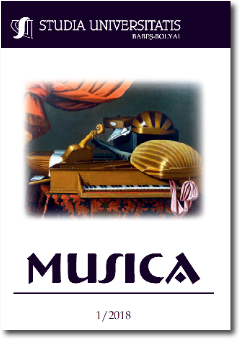A COMPLEX FOLK MUSIC EDUCATION SYSTEM FOR THE PREPARATORY YEARS OF MUSIC SCHOOLS: THE LESSONS OF A PEDAGOGICAL EXPERIMENT
A COMPLEX FOLK MUSIC EDUCATION SYSTEM FOR THE PREPARATORY YEARS OF MUSIC SCHOOLS: THE LESSONS OF A PEDAGOGICAL EXPERIMENT
Author(s): István Ferenc Bíró, Barbara RimánSubject(s): Fine Arts / Performing Arts
Published by: Studia Universitatis Babes-Bolyai
Keywords: folk music education; complexity; pedagogical experiment.
Summary/Abstract: The basis of our research was the István Ferenc Bíró’s study entitled Egyszer volt, hol nem volt, még a tantervi programon is túl… (2015) (Once upon a time... over the curricular programme), in which the author, on the basis of his preliminary experiments, considers Hungarian folk tales as a suitable framework for folk flute lessons. In a didactically oriented analysis, the author claims that the phases of folk tales correspond to those of folk flute lessons. The writer drew on his more than a decade experience in pedagogy; however, no pedagogical experiment has been carried out to justify his claims. Our research aims to make up for this deficiency. The experiment was carried out in a double-group pedagogical test. The students participating in the experiment are roughly of the same age and with similar capabilities, who took part in skill assessment both at the beginning and the end of the experiment. They got acquainted with the same number of child songs, in a vocal and instrumental form, and in the same number of lessons. The difference lay in the order of the set of tones and the forms of the reproduction of songs. The experimental group carried out their work in the order and way determined by the author, while the control group followed an order set by a commonly used textbook. The experiment proved that the folk tale framework does not only mean a motivational difference for the students, but due to the common linguistic and literary roots of folk songs and folk tales, the number of unknown words in folk songs also decreased. For those participating in the experimental group, an organic relationship evolved between the vocal and instrumental versions of folk songs, while the two versions were separated in the control group, as shown by the text-like interpretation of rhythm or its absence.
Journal: Studia Universitatis Babes-Bolyai - Musica
- Issue Year: 63/2018
- Issue No: 1
- Page Range: 151-160
- Page Count: 10
- Language: English

